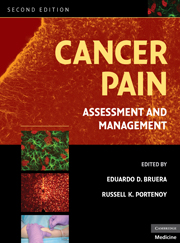Book contents
- Frontmatter
- Contents
- Contributors
- Preface
- SECTION I MECHANISMS AND EPIDEMIOLOGY
- SECTION II EPIDEMIOLOGY AND SYNDROMES
- SECTION III ASSESSMENT
- SECTION IV PHARMACOLOGICAL TREATMENT
- SECTION V OTHER INTERVENTIONAL STRATEGIES
- SECTION VI REHABILITATION AND PSYCHOLOGICAL INTERVENTIONS
- SECTION VII THE ROLE OF ANTINEOPLASTIC THERAPIES IN PAIN CONTROL
- SECTION VIII PAIN IN SPECIAL POPULATIONS
- SECTION IX DIFFICULT PAIN PROBLEMS
- SECTION X SYSTEMS OF CARE
- 29 Integrating cancer pain management into hospice practice and institution-based palliative care programs
- 30 Pain in medical illness: ethical and legal foundations
- 31 Understanding clinical trials in pain research
- 32 Legal and regulatory aspects of opioid treatment: the United States experience
- 33 Role of family caregivers in cancer pain management
- 34 Cancer pain and palliative care in the developing world
- Index
- Plate section
- References
33 - Role of family caregivers in cancer pain management
from SECTION X - SYSTEMS OF CARE
Published online by Cambridge University Press: 06 July 2010
- Frontmatter
- Contents
- Contributors
- Preface
- SECTION I MECHANISMS AND EPIDEMIOLOGY
- SECTION II EPIDEMIOLOGY AND SYNDROMES
- SECTION III ASSESSMENT
- SECTION IV PHARMACOLOGICAL TREATMENT
- SECTION V OTHER INTERVENTIONAL STRATEGIES
- SECTION VI REHABILITATION AND PSYCHOLOGICAL INTERVENTIONS
- SECTION VII THE ROLE OF ANTINEOPLASTIC THERAPIES IN PAIN CONTROL
- SECTION VIII PAIN IN SPECIAL POPULATIONS
- SECTION IX DIFFICULT PAIN PROBLEMS
- SECTION X SYSTEMS OF CARE
- 29 Integrating cancer pain management into hospice practice and institution-based palliative care programs
- 30 Pain in medical illness: ethical and legal foundations
- 31 Understanding clinical trials in pain research
- 32 Legal and regulatory aspects of opioid treatment: the United States experience
- 33 Role of family caregivers in cancer pain management
- 34 Cancer pain and palliative care in the developing world
- Index
- Plate section
- References
Summary
Introduction
Family caregivers continue to play a vital and ever-expanding role in meeting the practical, physical, and psychosocial needs of patients with cancer, including pain management. The past several years have seen a shift toward early hospital discharge, increasingly complex home-based treatment protocols, and rising expectations that caregivers participate actively in treatment-related decision making, the accomplishment of treatment goals – including symptom management – and home care. Yet policy, research, and clinical services for caregivers have not kept pace with these new developments.
As cancer treatment has changed, people with cancer have benefited greatly from early detection, aggressive multimodal treatment protocols, outpatient care, and longer survival times. These advances have been possible because in the United States, family caregivers form the foundation of the health care system, with an estimated 44.4 million caregivers providing informal care to ill relatives, with an expected economic value of about $350 billion in 2006.
Of the adults currently providing care to relatives in the United States, 60% are female, the average age is 45 years, and most are providing care for women aged 50 years and older. The amount of time devoted to caregiving is substantial, with most caregivers providing at least 40 hours of care each week and spending an average of 4.3 years as a caregiver. In a 1999 national survey of older adults in the last year of life, nearly three quarters reported receiving help from informal family caregivers.
- Type
- Chapter
- Information
- Cancer PainAssessment and Management, pp. 597 - 607Publisher: Cambridge University PressPrint publication year: 2009
References
- 1
- Cited by



